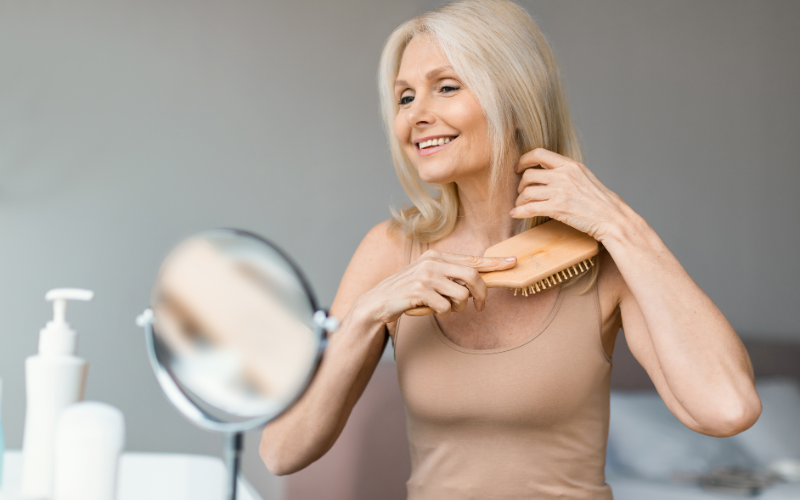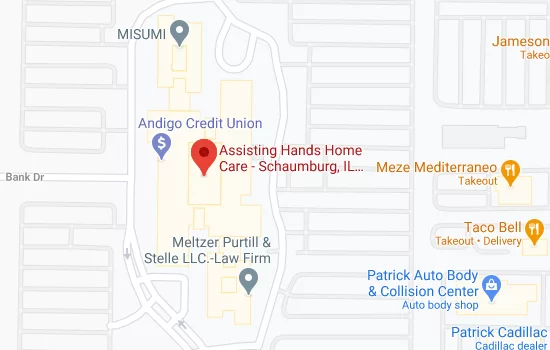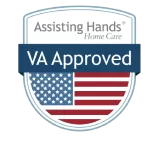What Is Aging in Place?
“Aging in place” describes the desire to live in your own home in later life, as long as you are able. Remaining in your own home may involve social support and home health care services to help you live safely and independently. Ensuring your living environment has been adapted to your abilities — including necessary home modifications — is key to aging in place successfully.

The American Association of Retired Persons (AARP) reports that nearly 90 percent of seniors want to stay in their own homes as they age. AARP research further notes that 69 percent of aging parents and 75 percent of their adult children think about the parents’ ability to live independently in the years ahead. But certain aging and health challenges can affect everyday activities for older adults inside and outside the home.
Unsafe Aging Conditions
 As loved ones age, balance becomes a significant issue due to a variety of factors, including physical weakness, medications, and cognitive and visual impairment. Normally a source of comfort for aging loved ones, the home can become hazardous without a fall-preventive strategy. We suggest you proactively and regularly assess the senior loved one’s home for anything that might be a health risk.
As loved ones age, balance becomes a significant issue due to a variety of factors, including physical weakness, medications, and cognitive and visual impairment. Normally a source of comfort for aging loved ones, the home can become hazardous without a fall-preventive strategy. We suggest you proactively and regularly assess the senior loved one’s home for anything that might be a health risk.
In addition, you should determine whether your loved one can do the following in a safe manner:
- Go up/down stairs
- Get in/out of bathtubs/showers
- Get up from/sit down on beds, chairs and toilets
- Reach up/bend down to retrieve items from closets and shelves
- Drive
- Use public transportation
- Maintain and keep up the home
- Manage one’s health
Aging in place requires an individualized plan that carefully considers a person’s functional abilities and any hazards and obstacles in the home. If you or your older loved one want to age in place — safely and comfortably — making practical home modifications may be the most beneficial solution.
Making Home Safe Again
Optional Home Modifications – For individuals who are relatively healthy but are starting to experience or are anticipating aging changes, these types of home modifications could help as they age.
- Add lighting
- Remove slick flooring
- De-clutter high foot traffic areas
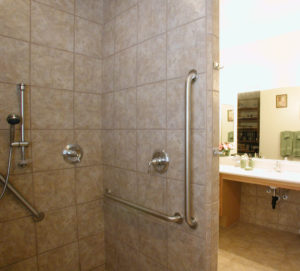 Needs-Based Home Modifications – Individuals with changing or chronic health conditions that affect balance and/or mobility will need a thorough assessment of how they function in their living environment.
Needs-Based Home Modifications – Individuals with changing or chronic health conditions that affect balance and/or mobility will need a thorough assessment of how they function in their living environment.
- Add bathroom grab bars
- Widen doorways
- Secure a personal emergency alert system
- Remove steps from entrances
- Convert doorknobs to handles
- Raise electrical outlets
- Lower electrical switches
Why Modify/Remodel Your Home to Age in Place?
- Increased safety
- Greater freedom to live independently
- Easier use by all family members
- Flexibility for changing health needs
Spotting Home Hazards
Hazard: Inadequate lighting
Solutions:
- Keep lights on in rooms most often occupied.
- Use brighter bulbs and more light fixtures.
- Consider a night light for dark passageways.
- During the day, open curtains and shades to let in more sunlight.
- Install extra lighting for pathways from bedroom to bathroom and by steps/stairways.
Hazards: Sliding throw rugs; Upended or curled carpet edges
Solutions:
- Use only slip-resistant rugs and mats (add nonskid matting to existing rugs, if needed).
- Add carpet tape to keep carpet edges from curling.
Hazard: Clutter
Solution: Clear all pathways and steps of objects and furnishings.
Resolving Difficulties at Home with:
Walking around?
• Wear shoes and slippers with nonslip soles that grip the floor.
• Consider using a cane to help maintain balance.
Getting up from chairs?
- Use sturdy chairs with armrests.
- Add firm foam pads to chair and sofa seats.
Getting up from the bed?
- Move the bed against the wall to prevent the bed from sliding.
- Replace the existing mattress with one thinner to lower the bed height or with one thicker to raise the bed height.
- Attach a handrail near the bed.

Getting in and out of the bathtub or shower?
- Consider a tub/shower chair and grab bars (towel bars are not designed for this).
- Place nonskid rubber mats or decals on the tub/shower floor.
Transitioning to the toilet?
- Consider an elevated toilet seat and grab bars.
Getting objects from kitchen cabinets and closet shelves?
- Store everyday dishes/kitchen supplies within easy reach.
- Keep items no lower than waist level or no higher than shoulder height to avoid excessive bending, stooping and reaching.
- If you must use a step stool, get one with a bar to hold on to; never use a chair as a step stool.
Walking up and down steps or stairs?
- Don’t rush; take your time and look directly at each step.
- Don’t carry large packages or baskets that obstruct your vision.
- Watch as you place each foot firmly on the steps.
- Clear stair steps of any items.
- Add handrails to all steps and stairs.
- Consider installing extra lighting at the top and bottom steps.
Stages of Behavior Change
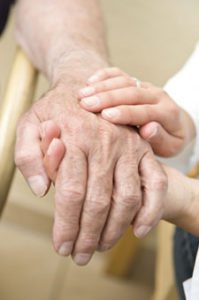 Acknowledging and accepting the need for living space modifications involves four stages of behavior change.
Acknowledging and accepting the need for living space modifications involves four stages of behavior change.
Stage 1: Pre-Contemplative/Unaware
- Individuals are not interested in change and do not see the need to change. They have no intention of doing anything differently.
- This group tends to avoid information, discussion or even thinking about change and the need for it.
- At this stage, it is useless to attempt modifications.
Stage 2: Contemplative
- People start to think about the possible need for changes.
- They recognize there is a problem and that they can and should do something.
- There may be a trigger event, such as a worsening of a person’s balance and/or a bad fall.
- At this stage, people are very open to information, options and specific strategies.
Stage 3: Action
People in this stage make real changes or modifications.
Stage 4: Maintaining
By this stage, people are working to consolidate any changes in their behavior, to maintain the “new” status quo and prevent a worsening of their condition. Praise and positive reinforcement are important.
Home-Monitoring Technology
Continuing advancements in technology allow more and more seniors to stay comfortable and secure at home, while providing peace of mind for family members. Home-monitoring technologies are becoming more affordable and user-friendly, including:
- Sensors – Installing sensors throughout the home can detect a senior’s change in routine, abnormal movements and falls. Sensor mats under mattresses monitor sleep patterns, heart rate and breathing.
- Wearable health devices – Health-centric technology worn as wristbands, biometric shirts, goggles and more measure everything from blood pressure to vision.
- Video monitoring – Elders can check in with relatives and friends via monitoring cameras or video conferencing.
- Mobile apps – Via smartphones and other mobile devices, apps can remind older adults to take their medication, or measure glucose or skin temperature on the spot, or adjust hearing volume.
- Telemedicine – Roving robotic devices allow doctors to remotely complete real-time medical appointments with aging home dwellers. At a distance, clinicians can also track heart rhythm paths for older patients with heart disease or who are at risk for stroke or heart attack.
- Home automation – Smart auto-set devices simplify daily tasks such as opening or securing windows and doors, turning off appliances, lowering countertops and shelves, and adjusting home temperature.
- Fall-detection devices – PERS (personal emergency response system) and passive sensors assess whether a fall has taken place and alert others that an individual has fallen.
Home Remodeling Check List
General Household
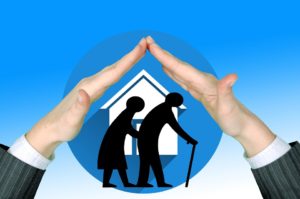 Adapt the lower floor of the home for possible one-level living.
Adapt the lower floor of the home for possible one-level living.- Arrange or remove furniture to allow for clear, wide passageways.
- Place electrical and phone cords out of the way and along the wall.
Bathroom
- Arrange for the shower to have a low threshold for easier entry/exit.
- Add grab bars at the back and sides of the shower, tub, and toilet.
- Be sure the shower and bathtub contain permanent or removable seating; bath benches can help with balance or transfer problems.
- Allow for turnaround and transfer space for a walker or wheelchair (36 inches x 36 inches).
- Convert to comfort-height toilets that are 2 to 3 inches higher than traditional models.
- Use anchored, decorative grab bars as towel bars.
- Add a nonskid mat or nonslip strips in the shower and/or bathtub.
- Choose out-swing, in-swing or pocket doors depending on mobility and access issues.
- Reinforce bathroom walls with blocking (i.e., a wood stud or other solid surface) so grab bars can be installed throughout the room.
- Be sure floor rugs are rubber-backed or secured with double-sided rug tape or rubber carpet mesh.
- Outfit the shower with a handheld or adjustable showerhead.
- Place bathroom cabinets and shelves within easy reach.
Bedroom
- Place the bed in a way that allows easy access to the bathroom.
- Secure large area rugs to the floor with doublesided tape or nonslip mats.
Closets and Cabinets
- Store medications, food, clothing and all frequently used items within easy reach; try to avoid using a stool or ladder to retrieve items.
- Use adjustable rods and shelves in closets and cabinets; consider pullout or pull-down shelves and automatic-close drawers.
Entrance/Exit
- Be sure at least one entry is without steps.
- Support walker/wheelchair access with doorways that are 36 inches wide with offset door hinges.
- Use door handles instead of knobs.
- Test to be sure patio doors and screens easily lock.
- Keep exterior pathways free of holes, loose bricks, uneven pavement, leaves or other tripping/slipping hazards.
- Clear entrances of clutter.
- Be sure doorway thresholds are designed to be non-trip.
- Secure handrails on both sides of all entrance/exit steps.
- Illuminate all exterior pathways, porches and doorways with exterior lighting.
- Add sensors to outdoor light fixtures to automatically turn lights on at dusk and off at dawn and/or turn on when motion is detected.
- Place a bench near the entrance door for placing packages on while locking/unlocking the door and for sitting on when tired.
Flooring
- Plan for contrast colors between floors and walls.
- Use only nonskid, matte-finish flooring.
- Polish floors with non-glare and non-slippery wax.
- Ensure low-pile carpeting is recessed and set level with the surrounding hard flooring.
- Use textured flooring materials to increase traction; carpeting should be low-pile or low-nap for easier walking or rolling over.
- Secure area rugs with a nonslip mat underneath or recess them to be level with surrounding materials.
- Avoid tiles or natural materials like marble that are slippery, especially when wet.
- Reduce noise with wood and cork flooring.
Kitchen
- Equip kitchen cabinets with pullout shelves and a Lazy Susan.
- Add easy-to-grasp cabinet knobs or pulls.
- Make appliances easier to reach; consider a raised dishwasher, a wall oven, refrigerator drawers, and washer and dryer pedestals.
- Replace kitchen cabinets with easier-access drawers and pullout shelves.
- Ensure a seated workspace in the kitchen (use a table, install a pullout work surface or remove lower cabinet doors and shelves).
- Use a step stool with nonslip surfaces and a firmgrip handle.
Lighting
- Increase incandescent general and specific-task lighting.
- Be sure there are adequate light levels throughout day and night hours
- Place automatic, light-sensor night lights in the kitchen, bath and other rooms.
- LED lights provide excellent illumination without overtaxing the wiring circuits and are easily dimmable.
- Add additional lighting to staircases and in hallways, either by plugging automatic lightsensor night lights into wall outlets or installing overhead fixtures or wall sconces.
- Use touch-control lamps and devices that automatically turn lights on and off at set times.
- Replace traditional toggle light switches with easier-to-use rocker panel switches.
- Install light switches that glow in the dark.
- Add lighting to closets.
- Use full-spectrum bulbs that simulate daylight.
- Use halogen bulbs to reduce glare.
- Open window shades, blinds and curtains for natural light during the day.
Seating and Chairs
- Be sure seating is at least 18 inches off the floor.
- Assist with the ease of getting up by using only chairs with sturdy armrests, and ensuring the chair/sofa arms extend to the front of the seat.
Stairs and Steps
- Use nonslip adhesive strips on stairs.
- Be sure safe and secure handrails are on both sides of the stairs and placed at a user-appropriate height and properly secured to the walls.
- Ensure that stairway lights can be turned on and off at both the top and bottom of the stairs.
- Ensure exterior stair treads are in good condition and that there are no weak or missing steps, loose bricks, raised nailheads, open backs, etc.
- See that carpeted steps have a nonslip surface such as adhesive strips.
- Clear all stairs of clutter.
- Choose tightly woven, low-pile carpet with thin padding for steps; be sure patterned carpet is not too busy to affect vision.
How Assisting Hands Home Can Help
If your loved one needs home care assistance, we offer caregiving services for almost any family and practically every situation. Our bonded/insured care professionals can help keep your loved ones safe at home.
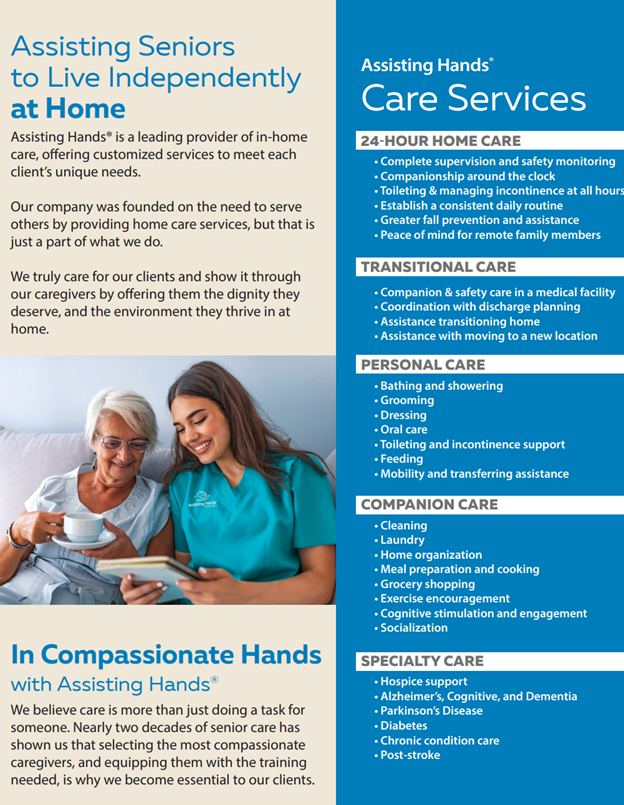
We can provide the following home care services:
- Supervise light exercise
- Assess the environment and suggest modifications.
- Prepare nutritious meals.
- Transport loved ones to medical appointments.
- Provide personal companionship.
- Help with other essentials to ensure the well-being of your senior or disabled adult.
Free Consultation
To learn more about our home health care services, contact Assisting Hands Home Care at (224) 258-0736.

Daniela has master’s degree in electronic engineering with a pedagogical specialty and master’s degree in marketing management.
After completing her schooling, Daniela worked at a hospital for 6 years as the Director of Business Marketing Development and Public Relations.
Starting Assisting Hands Home Care
Daniela spent more than 14 years as the Assistant Vice President of a national bank before becoming a co-owner of Assisting Hands Home Care of Schaumburg.
Her background in public relations and marketing along with her personal experience caring for her mother motivates Daniela to be passionate about helping families in the Schaumburg, IL area find exceptional caregiving services for their elderly loved ones.
Besides providing home care, Daniela enjoys giving back to the community in her free time, supporting various events at St. Peter Parish in Geneva, IL such as fundraising, school projects, charity events, and more. She also enjoys volunteering for the Humanitarian Service Project in Carol Stream, IL. This organization provides seniors with meals as well as food and supplies for children living in poverty.



